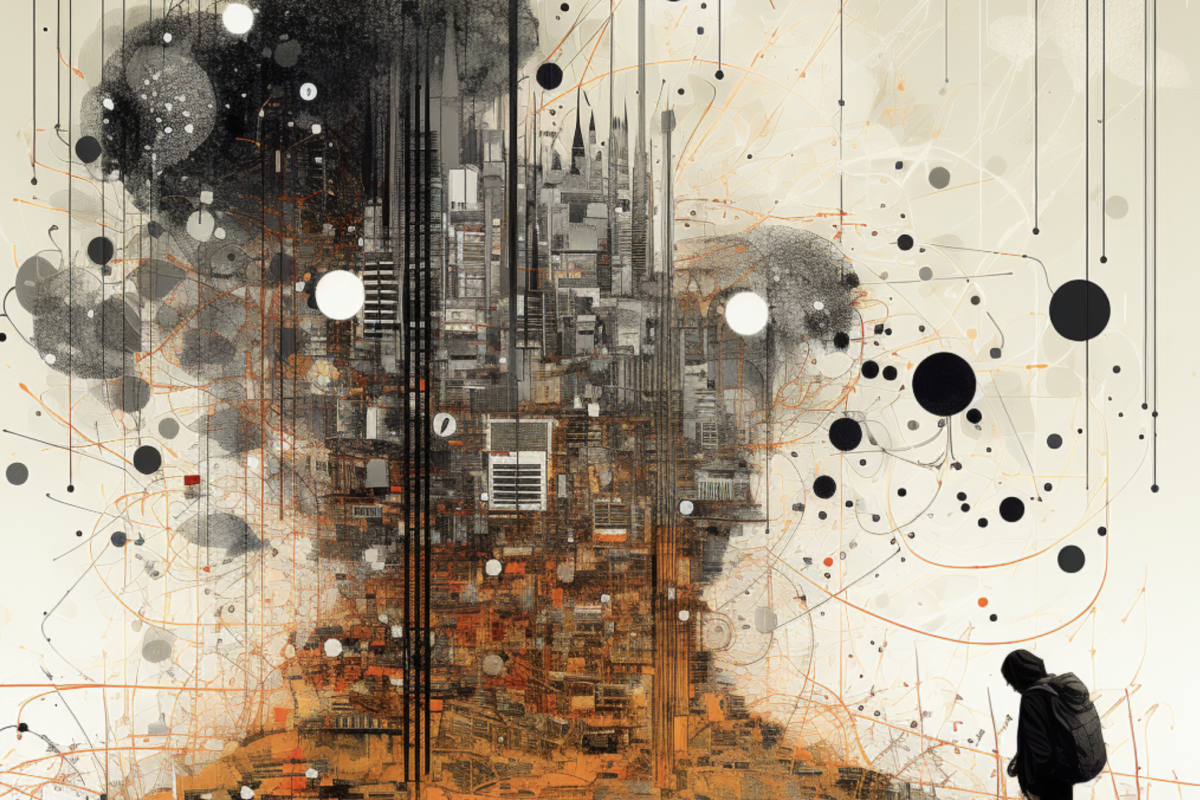Type “climate change” into an internet search engine and you’ll find 1.8 billion results, a confusing mass of studies, projections, models, opinions, and counter-opinions. Spend an hour or two sifting through it all and you’ll likely emerge feeling even less certain and more overwhelmed than you did when you started. UT Austin English professor Heather Houser has a word for that experience: “infowhelm.”
Though she didn’t coin the term, Houser did write the book on it, 2020’s Infowhelm: Environmental Art and Literature in an Age of Data, published by Columbia University Press. The broad concept of infowhelm can apply to a range of topics, from public health to politics, but Houser’s book focused on environmental science as a particularly potent source of such vertigo. Her book analyzes how artists — whether painters, writers, or photographers — process and depict being overwhelmed by environmental data.
“I think climate change and environmental issues are somewhat unique,” says Houser, “because the stakes of acting on them are so high. Artists help us manage the feelings associated with infowhelm, allowing audiences to contextualize science and inform action.”
In Infowhelm, Houser argues that artists are able to interpret, situate, and feel the effects of environmental data in a different, and perhaps more tangible, way than the scientists who produce and analyze it. Artists who are especially sensitive to infowhelm are often able to represent that experience in their work, she says, and that work may then go on to change the way readers and viewers think about the world.
Houser pays special attention to narratives, like Barbara Kingsolver’s 2012 novel Flight Behavior, that depict ordinary characters wrestling with overwhelming environmental data. The story follows Dellarobia Turnbow as the familiar world of her Appalachian forest is rendered bizarre by strange animal migrations that come about as a result of climate change. When Turnbow shares her discoveries with members of the scientific community, the abstract concepts of research, hypothesis, and data become all too concrete.
In Flight Behavior, says Houser, “we see a sort of newbie character, someone who is outside of the knowledge regime, who encounters people who are inside of it and is able to transform their processes of doubt and skepticism. In doing so, they create new types of knowledge.” She also argues that works like Flight Behavior and other art that evokes the experience of loss “allow the audience to engage with the feeling of extinction.”
If writers are able to mold data into psychological reality through their stories, visual artists hold the key to a different sort of informational alchemy. Houser points to Fazal Sheikh, a photographer who takes aerial photographs of the Israeli landscape. Through the bird’s-eye view of this traditionally scientific medium, Sheikh magnifies the effects of human settlement on the region, rendering this austere perspective of Earth’s surface into something haunting and beautiful. Alter the context and the composition, Sheikh’s work seems to say, and you’ll suddenly see the world not just as fact but as emotion.
“He shows the layers of changes to the Earth and reveals the fascinating processes of reforestation which are used to abet settlement in the area,” says Houser. “Sheikh gives us purchase on environmental destruction and social destruction by revealing the ‘big view’ and, in doing so, his art can give us purchase on environmental destruction.”
Houser is a literary scholar, not a scientist, and she’s careful to respect science’s many contributions to our understanding of the world and its changes. She’s also full of insights into how art and science can serve each other. Houser sees the relationship between the two disciplines as essentially symbiotic; to fully understand one, she says, you need the other.
“You can have science sitting next to emotion sitting next to speculation or questioning,” she says. “Through art, they can all live in the same sphere in a way that they can’t if you’re working strictly in an academic, intellectual tradition.”
Another of Houser’s interdisciplinary endeavors is Planet Texas 2050, a UT “Grand Challenge” initiative she co-founded in 2018 with the goal of shaping a growing Texas into a resilient and equitable state. The team is a mosaic of experts in the fields of sustainability, geosciences, theatre, biology, and engineering, and they often make use of illustration and interactive maps to convey their message.
“Since the inception of the project, we’ve incorporated the arts as integral to the program,” Houser says. “It was important to me that Planet Texas 2050 didn’t treat the arts simply as vehicles for communicating or humanizing the data because that subordinates them to the other aspects of the program. Instead, artworks — whether they be poems, performances, greeting cards, or escape rooms — produce knowledge about the Texas environment and the impacts of climate change. They can complicate the data picture or even challenge scientific ways of knowing. The arts also bring in other members of the campus and community that data modeling, engineering, biological sciences, or other disciplines might not so readily reach.”
The project, like her book, is just one of what Houser believes will have to be multitudes of strategies to contend both with infowhelm and the underlying environmental and other challenges that produce it. Data will continue to proliferate, as will debates about how to respond to it. If humanity is to effectively combat a degrading ecosystem and a warming planet, we will need galleries as well as laboratories to help us do it.
